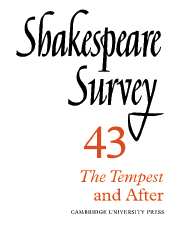Book contents
- Frontmatter
- The Power of Magic: From Endimion to The Tempest
- Reading The Tempest
- The Latter End of Prospero’s Commonwealth
- Henry VIII and the Deconstruction of History
- The Politics of Conscience in All is True (or Henry VIII)
- Shakespeare’s Romantic Innocents and the Misappropriation of the Romance Past: The Case of The Two Noble Kinsmen
- The Hand of John Fletcher in Double Falsehood
- ‘The Duke my Father’s Wrack’: The Innocence of the Restoration Tempest
- ‘Remember/First to Possess his Books’: The Appropriation of The Tempest 1700-1800
- The Tempest and After
- Poetry’s Sea-Changes: T. S. Eliot and The Tempest
- The New Function of Language in Shakespeare’s Pericles: Oath versus ‘Holy Word’
- The Discovery of The Rose Theatre: Some Implications
- The Origins of the Roxana and Messallina Illustrations
- Recycling the Early Histories: ‘The Wars of the Roses’ and ‘The Plantagenets’
- Shakespeare Production in England in 1989
- Professional Shakespeare Productions in the British Isles, January-December 1988
- The Year's Contributions to Shakespeare Studies: 1 Critical Studies
- 2 Shakespeare’s Life, Times, and Stage
- 3 Editions and Textual Studies
- Books Received
- Index
The Discovery of The Rose Theatre: Some Implications
Published online by Cambridge University Press: 28 March 2007
- Frontmatter
- The Power of Magic: From Endimion to The Tempest
- Reading The Tempest
- The Latter End of Prospero’s Commonwealth
- Henry VIII and the Deconstruction of History
- The Politics of Conscience in All is True (or Henry VIII)
- Shakespeare’s Romantic Innocents and the Misappropriation of the Romance Past: The Case of The Two Noble Kinsmen
- The Hand of John Fletcher in Double Falsehood
- ‘The Duke my Father’s Wrack’: The Innocence of the Restoration Tempest
- ‘Remember/First to Possess his Books’: The Appropriation of The Tempest 1700-1800
- The Tempest and After
- Poetry’s Sea-Changes: T. S. Eliot and The Tempest
- The New Function of Language in Shakespeare’s Pericles: Oath versus ‘Holy Word’
- The Discovery of The Rose Theatre: Some Implications
- The Origins of the Roxana and Messallina Illustrations
- Recycling the Early Histories: ‘The Wars of the Roses’ and ‘The Plantagenets’
- Shakespeare Production in England in 1989
- Professional Shakespeare Productions in the British Isles, January-December 1988
- The Year's Contributions to Shakespeare Studies: 1 Critical Studies
- 2 Shakespeare’s Life, Times, and Stage
- 3 Editions and Textual Studies
- Books Received
- Index
Summary
The remains of the Rose provide the first direct evidence concerning an Elizabethan public theatre. It will no doubt be some time before a full report on the excavations is available, and the significance of the finding can be fully established. The excavation nearby of a part of the foundations of the Globe may open up new perspectives on both this theatre and the Rose. It is possible, nevertheless, to begin to work out some implications provisionally of what is the most exciting theatre discovery in this century. The Rose was financed by Philip Henslowe in partnership with John Cholmley, and built by John Griggs, described in the deed of partnership as a carpenter, in 1587. Henslowe lists in his account-book or diary expenses for refurbishing the playhouse in the spring of 1592. The remains include part of the brick, chalk, and clunch or soft stone foundations of the original theatre, and also the foundations of a substantial extension northwards, including a new stage, which were presumably added in 1592. Hitherto the only visual evidence available has been that provided by John Norden in his three panoramas of London engraved one in 1593 and the others in 1600, which show the Rose schematically as hexagonal or round. The excavations carried out by the Department of Greater London Archaeology of the Museum of London have now brought to light what John Orrell and Andrew Gurr describe as ‘the first really trustworthy evidence about any of the playhouses that flourished in Shakespeare’s day’ in their preliminary report on the findings in the Times Literary Supplement, 9–15 June 1989; I have relied on their account for basic information.
- Type
- Chapter
- Information
- Shakespeare Survey , pp. 141 - 148Publisher: Cambridge University PressPrint publication year: 1991

